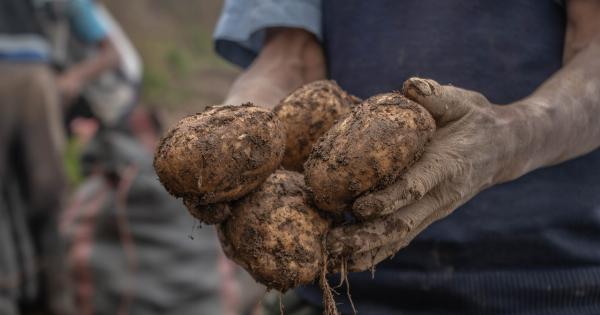Potatoes are an essential staple in many diets worldwide. They are packed with nutrients like carbohydrates, fiber, and potassium. They can also be cooked in different ways, making them versatile in the kitchen.
However, potatoes are not immune to diseases and pests that can affect their health, quality, and yield.
In this article, we will discuss the common signs that your potatoes could be affected by diseases or pests.
By being aware of these signs, you can take appropriate measures to prevent and treat the problem, ensuring that you still get healthy and delicious potatoes that are safe for consumption.
1. Hollow Heart
Hollow heart is characterized by a cavity in the center of the potato. The cavity is caused by an uneven growth rate, which can be due to many factors, including extreme temperatures, insufficient moisture, and high nitrogen levels.
The hollow heart does not affect the edibility of the potato, but it can reduce the quality and marketability of the crop.
To prevent hollow heart, farmers should practice proper crop management, including watering and fertilizing, and avoid exposing the crops to extreme environmental conditions.
2. Black Spot
Black spot is a common potato disease caused by the fungus Alternaria solani. The disease appears as circular or irregular-shaped black or dark brown spots on the potato skin.
As the spots grow, they can cause the potato flesh to rot, leading to reduced yield and quality.
To prevent black spot, farmers should use certified seed potatoes that are free from the disease, practice crop rotation, and use fungicides when necessary.
Infected potatoes should be discarded or carefully trimmed to prevent the spread of the disease.
3. Late Blight
Late blight is a serious potato disease caused by the water mold Phytophthora infestans. The disease is characterized by wilting, yellowing, and blackening of the leaves, stems, and tubers.
Late blight can spread rapidly, and infected crops should be destroyed to prevent further contamination.
To prevent late blight, farmers should use resistant potato varieties, practice crop rotation, and use fungicides when necessary.
Late blight can also be controlled using biological controls, such as Bacillus subtilis and Trichoderma harzianum, which are naturally occurring bacteria that can suppress the growth of the pathogen.
4. Common Scab
Common scab is caused by the bacterium Streptomyces scabies. The disease appears as rough, scabby lesions on the potato skin, which can reduce the quality and marketability of the crop.
Common scab is common in alkaline soils and soils with low organic matter content.
To prevent common scab, farmers should avoid planting potatoes in infected soils, practice crop rotation, and maintain optimal soil pH and organic matter content.
Fungicides and insecticides should also be used to control pests that can transmit the disease.
5. Wireworms
Wireworms are a type of beetle larvae that feed on potato tubers. The pests are thin, wire-like and can be difficult to detect until significant damage has already occurred.
Wireworms can cause reduced tuber size and yield, leading to economic losses for farmers.
To prevent wireworms, farmers should use certified seed potatoes, practice crop rotation, and use insecticides when necessary. Beneficial insects, such as ground beetles, can also be used to control wireworm populations naturally.
6. Potato Cyst Nematodes
Potato cyst nematodes are microscopic worms that live in the soil and feed on potato roots. The pests can reduce the yield and quality of potatoes and are difficult to control once established.
Potato cyst nematodes can be introduced to a field through contaminated soil or machinery.
To prevent potato cyst nematodes, farmers should use certified seed potatoes, practice crop rotation, and avoid planting potatoes in contaminated soils.
Infected crops should be destroyed, and equipment should be cleaned and disinfected to prevent the spread of the pests.
7. Fusarium Dry Rot
Fusarium dry rot is a potato disease caused by the fungus Fusarium spp. The disease appears as a dry, corky rot on the potato skin and flesh, which can lead to significant yield losses. Fusarium dry rot is common in storage and can spread rapidly.
To prevent Fusarium dry rot, farmers should store potatoes in dry and cool conditions and avoid any mechanical damage when handling the crops.
Infected potatoes should be removed and disposed of, and storage facilities should be cleaned and disinfected to prevent the spread of the fungus.
8. Potato Leafhoppers
Potato leafhoppers are small insects that feed on the leaves of potato plants. The pests can cause stunted growth, yellowing, and curling of the leaves, leading to reduced yield and quality.
Potato leafhoppers can reproduce rapidly and cause significant damage to crops.
To prevent potato leafhoppers, farmers should use insecticides when necessary, practice crop rotation, and avoid late planting. Beneficial insects, such as parasitic wasps and ladybugs, can also be used to control leafhopper populations naturally.
9. Potato Tuber Moth
Potato tuber moth is a pest that feeds on the potato tubers and can cause significant damage to crops. The moth larvae tunnel into the tubers, causing rot and decay. Potato tuber moths are common in warmer climates and can be difficult to control.
To prevent potato tuber moth, farmers should use certified seed potatoes, practice crop rotation, and use insecticides when necessary.
Beneficial insects, such as parasitic wasps and tachinid flies, can also be used to control potato tuber moth populations naturally.
10. Bacterial Soft Rot
Bacterial soft rot is a potato disease caused by the bacteria Erwinia spp. The disease appears as a soft, slimy rot on the potato skin and flesh, which can reduce the quality and marketability of the crop.
Bacterial soft rot is common in humid and warm conditions and can spread rapidly.
To prevent bacterial soft rot, farmers should store potatoes in dry and cool conditions, avoid any mechanical damage when handling the crops, and use fungicides when necessary.
Infected potatoes should be removed and disposed of, and storage facilities should be cleaned and disinfected to prevent the spread of the disease.
Conclusion
Overall, potatoes are susceptible to many diseases and pests that can affect their health, quality, and yield.
By being aware of these common signs, you can take appropriate measures to prevent and treat the problem, ensuring that you still get healthy and delicious potatoes that are safe for consumption.
However, prevention is always better than cure, and farmers should practice good crop management, including crop rotation, use of certified seed potatoes, and timely use of fungicides and insecticides when necessary, to keep their potatoes healthy and thriving.































